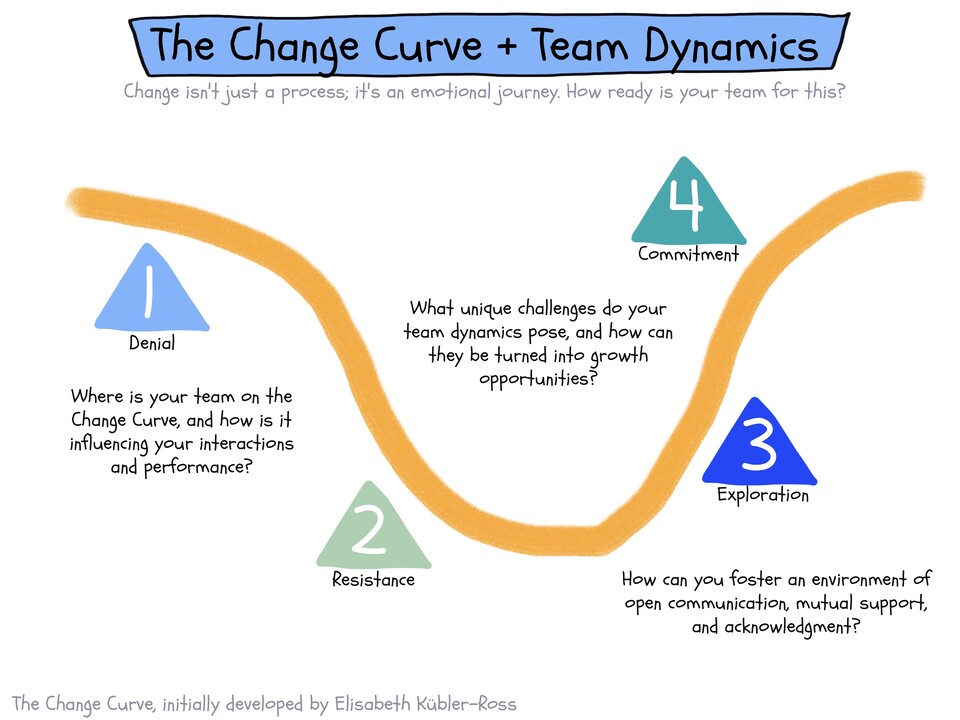
GUEST POST from Stefan Lindegaard
As the pace of change accelerates and becomes more encompassing, teams stand as the backbone of a successful organization. To stay ahead, teams must not only adapt to change but also leverage it to their advantage.
So, how do we harness change management to ensure our teams remain robust and agile through ongoing transformations and uncertainties?
By integrating team dynamics with change management, we aim to transform not only how teams operate but also how individuals perceive and engage with change.
That’s why I’m developing the Team Dynamics for Change Management Framework, and I invite your feedback and perspectives on it.
Understanding Change Management:
Change Management is the structured approach to transitioning teams or organizations from their current state to a desired future state. It’s about guiding and supporting individuals through this transition to realize lasting benefits. A significant part of this involves understanding people – their perceptions of change and how best to aid them through it.
Defining Team Dynamics:
Team dynamics are the behavioral and psychological forces at play within a group, profoundly influencing its direction and overall performance. These forces spring from individual personalities, relationships, roles, and the environment the team operates within. They mold the team’s interactions, communication patterns, collaborative efforts, and conflict resolutions.
Why a Framework for This Makes Sense
While numerous change management models cater to organizational or individual change, few focus directly on the unique behaviors and interactions within teams.
Given the pivotal role of teams, it’s essential to have an approach that marries the principles of change management with the realities of team dynamics.
Inspiration & Roots:
Two groundbreaking models serve as the foundational inspiration for this approach:
Kotter’s 8-Step Process for Leading Change: Developed by Harvard Business School Professor John Kotter, this model provides a step-by-step strategy for organizational change. Its emphasis on creating urgency, building a guiding coalition, and embedding new approaches makes it a revered guide in change management.
ADKAR Model: Introduced by Prosci, a global leader in change management solutions, this model emphasizes the individual’s journey through change. Its focus on Awareness, Desire, Knowledge, Ability, and Reinforcement captures the stages of personal transition during organizational shifts.
Choosing these models as the foundation is due to their robust, time-tested strategies, which I believe can be tailored to address team dynamics specifically.

Eight (8) Elements for the Team Dynamics for Change Management Framework
1. Assessing Team Dynamics:
Objective: Understand the current state and behaviors within the team.
Rationale: Before any change management strategy can be effectively implemented, there’s a need to understand the present dynamics of the team. This sets the foundation for everything that follows.
2. Understanding Individual Aspirations (WIIFM):
Objective: Recognize and validate the personal drivers and motivations of each team member.
Rationale: Following the assessment of team dynamics, it’s critical to delve deeper into individual motivations. Understanding the “what’s in it for me?” for every team member will influence and enrich subsequent steps, ensuring changes resonate on a personal level.
3. Evaluating Team Change Readiness:
Objective: Gauge the team’s willingness and preparation for change, considering both collective and individual motivations.
Rationale: Once the team dynamics and individual aspirations are clear, it’s pivotal to measure the readiness for change, which will be greatly influenced by the alignment (or lack thereof) between team goals and personal drivers.
4. Formulating a Shared Vision:
Objective: Create a unified direction for the team that also respects individual aspirations.
Rationale: Armed with insights from previous steps, crafting a shared vision becomes more feasible and grounded. This vision will better reflect the aspirations of the team as a whole and its individual members.
5. Enhancing Communication & Collaboration:
Objective: Foster positive and efficient team interactions.
Rationale: With a clear vision in place, the focus can shift to enhancing the ways team members interact, ensuring that individual aspirations and the collective vision are continually in dialogue.
6. Implementing Change & Skill Development:
Objective: Facilitate the smooth adoption of new practices while building necessary skills.
Rationale: Changes can now be introduced and executed, backed by a well-understood team dynamic and vision, and supported by individual motivations.
7. Feedback & Continuous Improvement:
Objective: Monitor the impact of the changes and refine as necessary.
Rationale: As changes are implemented, it’s essential to keep the channels of feedback open. Here, the alignment between team goals and individual motivations will be rechecked and fine-tuned.
8. Celebrating Success & Expanding Impact:
Objective: Recognize achievements and share the team’s journey with a wider audience.
Rationale: Concluding with acknowledgment reinforces the importance of both the collective endeavor and individual contributions. Celebrations serve as reminders of the harmony between team goals and personal aspirations.
What’s in it for Teams:
- A clearer path through organizational changes.
- Enhanced trust, teamwork, and collaboration.
- Fewer conflicts and more transparent communication channels.
- Readiness for upcoming challenges.
- Foster an environment where everyone thrives.
- Provides individuals clarity on their roles, highlighting the unique value they bring to the organization, reducing uncertainty.
Help develop our framework? Get a free e-book!
I’m in the process of refining this framework and would greatly value your perspectives. If you have insights, feedback to offer or questions to ask, please get in touch. Let’s work together to redefine how teams adapt to change. I will soon turn this into a free e-book to share the learning.
Image Credit: Stefan Lindegaard, Unsplash
![]() Sign up here to get Human-Centered Change & Innovation Weekly delivered to your inbox every week.
Sign up here to get Human-Centered Change & Innovation Weekly delivered to your inbox every week.

